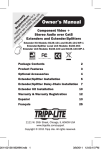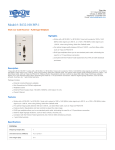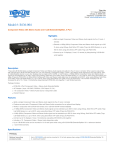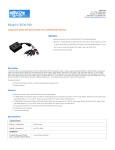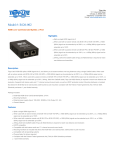Download Tripp Lite VGA with Audio over Cat5/Cat6 Extender Kit, Box-Style Transmitter & Receiver with EDID Copy, 1920x1440 at 60Hz
Transcript
Owner’s Manual VGA Over Cat5 Extenders and Extender/Splitters Extender Kit Models: B130-101-2, B130-101A-2, B130-101-WP-1, B130-101A-WP-2, B130-101S-2, B130-111, B130-111A and B130-101-U Transmitter Unit Models: B132-002-2, B132-002A-2, B132-004-2 and B132-004A-2 Receiver Unit and Remote Repeater Models: B132-100-1, B132-100A, B132-100-WP-1, B132-100A-WP-1, B132-110 and B132-110A 1111 W. 35th Street, Chicago, IL 60609 USA • www.tripplite.com/support 14-11-071-9333F9.indd 1 Copyright © 2014 Tripp Lite. All rights reserved. All trademarks are the sole property of their respective owners. 1 11/20/2014 4:42:42 PM Table of Contents Package Contents 3 Product Features 4 All 4 B130-101-24 B130-101A-24 B130-101-WP-14 B130-101A-WP-25 B130-101S-25 B130-1115 B130-111A6 B130-101-U6 B132-002-27 B132-002A-27 B132-004-27 B132-004A-28 B132-100-18 B132-100A8 B132-100-WP-18 B132-100A-WP-18 B132-1109 B132-110A9 14-11-071-9333F9.indd 2 Optional Accessories 10 Mounting Hardware Instructions 11 Installation12 EDID Copy 12 Extender Kit Installation 14 Non-Kit Standard Installation 17 Non-Kit Daisy Chain Installation 19 Extender/Repeater Kit 21 Installation Non-Kit Remote Repeater 24 Installation Non-Kit Daisy Chain Remote 27 Repeater Installation Troubleshooting31 Warranty and Product Registration 34 Additional Warnings and Notices 35 2 11/20/2014 4:42:42 PM B130-101-2 B130-101A-2 B130-101-WP-1 B130-101A-WP-2 B130-101S-2 B130-111 B130-111A B130-101-U B132-002-2 B132-002A-2 B132-004-2 B132-004A-2 B132-100-1 B132-100A B132-100-WP-1 B132-100A-WP-1 B132-110 B132-110A Package Contents Local Unit (L), Remote Unit (R) or Both (B) 1 or 2 External Power Supplies (Input: 100240 V, 50/60 Hz, 0.5 A Output: 5 V, 2 A) Mounting Hardware Wallplate Screws Screwdriver 3.5 mm Male to DB9 Male Adapter Cable 3.5 mm Male to DB9 Female Adapter Cable 1 ft. VGA Splitter Cable 1 ft. VGA + Audio Splitter Cable 1 ft. VGA Daisy Chain Cable 1 ft. VGA + Audio Daisy Chain Cable 14-11-071-9333F9.indd 3 B B B B B B B B L L L L R R R R R R 2 2 2 2 2 2 2 0 1 1 1 1 1 1 1 1 1 1 X X X X X X X X X X X X X X X X X X X X X X X X X X X X X X X X X X X X X 3 11/20/2014 4:42:42 PM Product Features All •Support a maximum resolution of 1920 x 1440 @ 60 Hz. •All operating systems supported. •Plug and play; no software or drivers required. •HDCP compliant. B130-101-2 • Extends a VGA video signal (1024 x 768 @ 60 Hz) up to 1,000 ft. from the source. • Features an additional VGA port, allowing for the connection of a local monitor. • Includes mounting hardware that allows units to be wall-mounted, rack mounted or pole mounted. • Features built-in equalization and gain controls to adjust the video image. •EDID copy feature ensures optimal display compatibility. B130-101A-2 • Extends both a VGA video (1024 x 768 @ 60 Hz) and an audio signal up to 1,000 ft. from the source. • Features additional VGA and 3.5 mm ports, allowing for the connection of a local monitor and speakers. • Includes mounting hardware that allows units to be wall-mounted, rack mounted or pole mounted. • Features built-in equalization and gain controls to adjust the video image. •EDID copy feature ensures optimal display compatibility. B130-101-WP-1 • Extends a VGA video signal (1024 x 768 @ 60 Hz) up to 1,000 ft. from the source. • Includes a VGA splitter cable, which allows for the connection of a local monitor. • Includes RJ45 jacks, allowing for easy connection via standard patch cables; no 110 punchdown connections required. • Features built-in equalization and gain controls to adjust the video image. 4 14-11-071-9333F9.indd 4 11/20/2014 4:42:42 PM Product Features continued B130-101A-WP-2 • Extends both a VGA video (1024 x 768 @ 60 Hz) and an audio signal up to 1,000 ft. from the source. • Includes a VGA + audio splitter cable, which allows for the connection of a local monitor and speakers. • Includes RJ45 jacks, allowing for easy connection via standard patch cables; no 110 punchdown connections required. • Features built-in equalization and gain controls to adjust the video image. •EDID copy feature ensures optimal display compatibility. B130-101S-2 • Extends both a VGA video (1024 x 768 @ 60 Hz) and RS-232 Serial signal up to 1,000 ft. from the source. • Includes mounting hardware that allows units to be wall-mounted, rack mounted or pole mounted. • Features built-in equalization and gain controls to adjust the video image. •EDID copy feature ensures optimal display compatibility. B130-111 •Kit comes with both local transmitter and remote repeater units. •Locate multiple monitors at different points in a chain of up to 2,000 ft. by connecting an additional remote receiver unit (B132-100-1 or B132-100-WP-1), or a remote repeater unit (B132-110). •Up to 4 remote units (3 remote repeaters and 1 receiver) can be connected together, providing video to up to 4 remote displays in a full chain. •Extends a 1024 x 768 (60 Hz) signal up to 1,000 ft. between the local transmitter and the first remote repeater unit in the installation. •Extends a 1024 x 768 (60 Hz) signal up to an additional 1,000 ft. from the first remote repeater unit to the last display in the installation, for a maximum extension distance of 2,000 ft. •Local unit includes an additional VGA port, allowing for the connection of a local monitor. •Features built-in equalization and gain controls to adjust the video image. •Includes mounting hardware that allows units to be wall-mounted, rack mounted or pole mounted. 5 14-11-071-9333F9.indd 5 11/20/2014 4:42:42 PM Product Features continued B130-111A •Kit comes with both local transmitter and remote repeater units. •Locate multiple monitors/speakers at different points in a chain of up to 2,000 ft. by connecting an additional remote receiver unit (B132-100A or B132-100A-WP-1), or a remote repeater unit (B132-110A). •Up to 4 remote units (3 remote repeaters and 1 receiver) can be connected together, providing audio/video to up to 4 remote displays/ speakers in a full chain. •Extends a 1024 x 768 (60 Hz) video and audio signal up to 1,000 ft. between the local transmitter and the first remote repeater unit in the installation. •Extends a 1024 x 768 (60 Hz) video and audio signal up to an additional 1,000 ft. from the first remote repeater unit to the last set of display and speakers in the installation, for a maximum extension distance of 2,000 ft. •Local unit includes additional VGA video and 3.5 mm audio ports, allowing for the connection of a local monitor and speakers. •Features built-in equalization and gain controls to adjust the video image. •Includes mounting hardware that allows units to be wall-mounted, rack mounted or pole mounted. B130-101-U •Extends a VGA video signal (1024 x 768 @ 60 Hz) up to 500 ft. from the source. •Power is supplied by the USB connection on the local transmitter unit; no external power supplies are required. •Dongle-style local and remote units come with built-in VGA connectors; no external VGA cables are required. •Features built-in equalization and gain controls to adjust the video image. 14-11-071-9333F9.indd 6 6 11/20/2014 4:42:42 PM Product Features continued B132-002-2 • Works with the B132-100-1 and B132-100-WP-1 remote units to extend a VGA video signal (1024 x 768 @ 60 Hz) up to 1,000 ft. from the source. • Able to transmit a single VGA video signal to 2 monitors. • Includes mounting hardware that allows unit to be wall-mounted, rack mounted or pole mounted. •EDID copy feature ensures optimal display compatibility. B132-002A-2 • Works with the B132-100A and B132-100A-WP-1 remote units to extend both a VGA video (1024 x 768 @ 60 Hz) and an audio signal up to 1,000 ft. from the source. • Transmits a single VGA video and audio signal to 2 sets of monitors and speakers. • Includes mounting hardware that allows unit to be wall-mounted, rack mounted or pole mounted. •EDID copy feature ensures optimal display compatibility. B132-004-2 • Features an additional VGA port, allowing for the connection of a local monitor. • Works with the B132-100-1 and B132-100-WP-1 remote units to extend a VGA video signal (1024 x 768 @ 60 Hz) up to 1,000 ft. from the source. • Able to transmit up to 5 (4 remote, 1 local) VGA video signals. • Expand the number of connected monitors to up to 25 (24 remote, 1 local) by daisy chaining up to 6 local units together. Note: B132-002-2 local units cannot be daisy chained. • Includes mounting hardware that allows unit to be wall-mounted, rack mounted or pole mounted. •EDID copy feature ensures optimal display compatibility. • Up to three local units can be connected to a Tripp Lite B132-004-RB rackmount bracket and mounted in just 1U of rack space. 14-11-071-9333F9.indd 7 7 11/20/2014 4:42:42 PM Product Features continued B132-004A-2 • Works with the B132-100A and B132-100A-WP-1 remote units to extend both a VGA video (1024 x 768 @ 60 Hz) and an audio signal up to 1,000 ft. from the source. • Features additional VGA and 3.5 mm ports, allowing for the connection of a local monitor and speakers. • Transmits a single VGA video and audio signal to up to 5 sets (4 remote, 1 local) of monitors and speakers. • Expand the number of connected monitors/speakers to up to 25 (24 remote, 1 local) by daisy chaining up to 6 local units together. Note: B132-002A-2 local units cannot be daisy chained. • Includes mounting hardware that allows unit to be wall-mounted, rack mounted or pole mounted. • Up to three local units can be connected to a Tripp Lite B132-004-RB rackmount bracket and mounted in just 1U of rack space. •EDID copy feature ensures optimal display compatibility. B132-100-1 • Includes mounting hardware that allows unit to be wall-mounted, rack mounted or pole mounted. • Features built-in equalization and gain controls to adjust the video image. B132-100A • Includes mounting hardware that allows unit to be wall-mounted, rack mounted or pole mounted. • Features built-in equalization and gain controls to adjust the video image. B132-100-WP-1 • Includes RJ45 jacks, allowing for easy connection via standard patch cables; no 110 punchdown connections required. • Features built-in equalization and gain controls to adjust the video image. B132-100A-WP-1 • Includes RJ45 jacks, allowing for easy connection via standard patch cables; no 110 punchdown connections required. • Features built-in equalization and gain controls to adjust the video image. 8 14-11-071-9333F9.indd 8 11/20/2014 4:42:43 PM Product Features continued B132-110 •Both extends and expands your Tripp Lite VGA over Cat5 installation, allowing you to locate multiple monitors at different points in a chain of up to 2,000 ft. •Up to 4 remote units (3 remote repeaters and 1 receiver) can be connected together, providing video to up to 4 remote displays in a full chain. •Extends a 1024 x 768 (60 Hz) signal up to 1,000 ft. between the local transmitter and the first remote repeater unit in the installation. •Extends a 1024 x 768 (60 Hz) signal up to an additional 1,000 ft. from the first remote repeater unit to the last display in the installation, for a maximum extension distance of 2,000 ft. •Features built-in equalization and gain controls to adjust the video image. •Includes mounting hardware that allows unit to be wall-mounted, rack mounted or pole mounted. B132-110A •Both extends and expands your Tripp Lite VGA + audio over Cat5 installation, allowing you to locate multiple monitors/speakers at different points in a chain of up to 2,000 ft. •Up to 4 remote units (3 remote repeaters and 1 receiver) can be connected together, providing audio/video to up to 4 remote displays/ speakers in a full chain. •Extends a 1024 x 768 (60 Hz) video and audio signal up to 1,000 ft. between the local transmitter and the first remote repeater unit in the installation. •Extends a 1024 x 768 (60 Hz) video and audio signal up to an additional 1,000 ft. from the first remote repeater unit to the last set of display and speakers in the installation, for a maximum extension distance of 2,000 ft. •Features built-in equalization and gain controls to adjust the video image. •Includes mounting hardware that allows unit to be wall-mounted, rack mounted or pole mounted. 14-11-071-9333F9.indd 9 9 11/20/2014 4:42:43 PM Optional Accessories • B132-004-RB 1U Rackmount Bracket • N022-01K-GY Gray Cat5e Bulk 24 AWG Solid Cable – 1,000 ft. • N030-010 10-pack of RJ45 Plugs for Solid-wire Cat5e Cable • N202-Series Cat6 Snagless 24 AWG Solid Patch Cables • N222-01K-GY Gray Cat6 Bulk 24 AWG Solid Cable – 1,000 ft. • P312-Series Audio Cables • P502-Series VGA Monitor Cables with RGB Coax • P504-Series VGA Monitor + Audio Cables with RGB Coax • P520-006 RS-232 Serial Extension Cable – 6 ft. • P524-01K Zero-Skew UTP Bulk Cable – 1,000 ft. 14-11-071-9333F9.indd 10 10 11/20/2014 4:42:43 PM Mounting Hardware Instructions All of the non-wallplate VGA extender products come with mounting hardware that allows them to be mounted in a variety of ways. The following images show the different ways the included mounting brackets can be attached for different mounting methods. Note: The images below show a B140-101X DVI Extender, but mounting is the same for the VGA Extenders. The B132-004-2 and B132-004A-2 can also be mounted to a Tripp Lite B132-004-RB 1U rackmount bracket. Up to 3 B132-004-2 or B132-004A-2 local units can be connected to a B132-004-RB. Wall-Mount 1 Wall-Mount 2 19” Rack Mount Pole Mount 14-11-071-9333F9.indd 11 11 11/20/2014 4:42:44 PM Installation EDID Copy Compatibility issues can occur when EDID information is not properly communicated between the source and the display. Select models include an EDID copy feature which stores a monitor’s EDID information in the transmitter and sends it to the source, ensuring optimal compatibility. The transmitter can only store EDID information copied from a single monitor. Follow this guideline when choosing which monitor to copy EDID information from: the lowest supported resolution of the monitor you choose should also be supported by the other monitors you plan to use in the installation. For example, if you plan to use three monitors that support the resolutions listed below, you should copy the EDID information from monitor A because the lowest resolution it supports (1024 x 768) is also supported by monitors B and C. (Monitor A is also a good choice because all of its supported resolutions are also supported by monitors B and C.) A.1920 x 1080, 1600 x 1200, 1024 x 768 B.1920 x 1080, 1680 x 1050, 1600 x 1200, 1024 x 768, 800 x 600 C.1920 x 1080, 1680 x 1050, 1280 x 768, 1600 x 1200, 1152 x 768, 1024 x 768, 800 x 600 If you are not using the EDID copy feature, the transmitter will use a default set of EDID information. Note: VGA over Cat5 Extender Kits and Transmitter units with a -2 at the end of their model name support the EDID copy feature. Remote units will support EDID copy as long as they are used with a Transmitter unit that supports it. To use the EDID copy feature, follow the instructions below: 1 Determine the monitor to perform the EDID copy on, choosing the monitor that has the lowest common resolution among those that you will be connecting (see example above). 2 Connect the powered-on monitor to the input port of the transmitter unit. Note: When using the B130-101A-WP-2, you must connect the monitor directly to the VGA port on the transmitter. If you use the VGA + Audio splitter cable, EDID Copy will not work, and generic EDID information will be used by the transmitter. 14-11-071-9333F9.indd 12 12 11/20/2014 4:42:44 PM Installation continued 3 Connect the external power supply to the transmitter unit and plug it into a Tripp Lite Surge Suppressor, Power Distribution Unit (PDU) or Uninterruptible Power Supply (UPS). 4 Wait 10 seconds for the EDID information to be copied, and then disconnect the monitor from the transmitter unit’s input port and proceed per the installation instructions in this manual. 5 You can verify that the EDID information was copied via the Display Settings screen in your computer. If the model name of the monitor that you copied is shown in the Display field of the screen, the EDID information has been copied successfully. 6 (Optional) – If you want to reset the EDID information stored in the transmitter, perform these steps again, but instead of connecting the monitor to the transmitter’s input port, connect the transmitter’s output port to its input port. Note: The B130-101A-WP-2 does not have an EDID reset function. To default to generic EDID with the B130-101A-WP-2, connect the VGA + Audio splitter cable to the transmitter unit. 14-11-071-9333F9.indd 13 13 11/20/2014 4:42:45 PM Installation continued Extender Kit Installation (B130-101-2, B130-101A-2, B130-101-WP-1, B130-101A-WP-2, B130-101S-2, B130-101-U) Receiver Unit Transmitter Unit Note: 1.For models that support EDID copy, perform the EDID copy procedure described in this manual prior to installation. 2.The diagram above shows a B130-101A-2 VGA + Audio Extender Kit installation. Installation will be the same for other extender kit models, with the exception of units featuring VGA + RS-232 serial or VGA only. The B130-101-U gets power from the USB cable built-in to the local unit, and doesn’t require external power supplies. 3.Test to make sure the entire installation works properly before pulling cables through ceilings/walls. 4.To achieve maximum distance and performance, 24 AWG solid-wire Cat5e/6 cable must be used. The use of stranded wire Cat5e/6 cable, or cable with a gauge (AWG) size higher than 24 AWG, will result in shorter extension distance. All Tripp Lite N202-Series cables are made with 24 AWG solid-wire cabling. Tripp Lite N022-01K-GY (Cat5e) and N222-01K-GY (Cat6) are 24 AWG solid-wire bulk cables. For optimal image quality between 500 and 1,000 ft., use ZeroSkew cable, such as Tripp Lite P524-01K. For the B130-101-U, use Zero-Skew cable for distances between 250 and 500 ft. 5. To achieve maximum resolution, it is recommended that you use Tripp Lite P502-Series VGA video or P504-Series VGA video and audio* cables with RGB coax. *If this is a feature of your extender kit. 14-11-071-9333F9.indd 14 14 11/20/2014 4:42:45 PM Installation continued 1 Make sure that the VGA, audio* and RS-232 serial* source is powered off. 2 (B130-101-2, B130-101A-2 and B130-101S-2 only) – Connect the VGA and audio* source to the INPUT port(s) on the transmitter unit using a VGA and audio* cable. 3 (B130-101S-2 only) – Connect the included 3.5 mm Male to DB9 Female adapter cable to the 3.5 mm INPUT port on the transmitter unit, and then connect the computer to the adapter using a DB9 cable. 4 (B130-101-U only) – Connect the built-in VGA and USB connectors on the transmitter unit to the source computer. 5 (B130-101-WP-1 and B130-101A-WP-2 only) – If you wish to connect a local monitor and speakers*, connect the male end of the included splitter cable to the INPUT port(s) on the transmitter unit, and then connect one of the female ends of the splitter cable to the source using VGA and audio* cable. If you are not connecting a local monitor and speakers*, the source can be connected directly to the INPUT port(s) on the transmitter unit without using the included splitter cable. 6 (Optional) – Connect a local monitor and speakers* to the LOCAL port(s) on the transmitter unit, or the remaining female connector(s) on your splitter cable*, using a VGA and audio* cable. Note: The B130-101S-2 comes with a local video port only, and does not contain a local RS-232 Serial port. 7 Connect the external power supply to the transmitter unit, and then plug it into a Tripp Lite Surge Suppressor, Power Distribution Unit (PDU) or Uninterruptible Power Supply (UPS). The B130-101-U gets power from the USB cable built-in to the transmitter unit and doesn’t require external power supplies. 8 Using Cat5e/6 cable, connect the RJ45 OUTPUT port on the transmitter unit to the RJ45 INPUT port on the receiver unit. 9 (B130-101-U only) – Connect the built-in VGA connector on the receiver unit to the VGA port on a monitor. *If this is a feature of your extender kit. 14-11-071-9333F9.indd 15 15 11/20/2014 4:42:45 PM Installation continued 10 Connect a monitor and speakers* to the OUTPUT ports on the receiver unit using a VGA and audio* cable. 11 (B130-101S-2 only) – Connect the included 3.5 mm Male to DB9 Male adapter cable to the 3.5 mm OUTPUT port on the receiver unit, and then connect the serial device to the adapter using a DB9 cable. 12 Connect the external power supply to the receiver unit, and then plug it into a Tripp Lite Surge Suppressor, Power Distribution Unit (PDU) or Uninterruptible Power Supply (UPS). The B130-101-U gets power from the USB cable built-in to the transmitter unit and doesn’t require external power supplies. 13 Turn on the power to the monitor, speakers* and RS-232 serial device.* 14 Turn on the power to the monitor, audio* and RS-232 serial* source. 15 If necessary, adjust the equalization and gain controls using the included screwdriver to improve the video image. Note: The B130-101-U receiver unit contains a switch that changes the upper and lower limits of the Gain adjustment control depending on the length of your installation. If using 50 ft. or less of Cat5e/6 cable, this setting should be L. If over 50 ft., it should be set to H. *If this is a feature of your extender kit. 14-11-071-9333F9.indd 16 16 11/20/2014 4:42:45 PM Installation continued Non-Kit Standard Installation B132-100A Source PC B132-004A-2 B132-100A-WP-1 Note: 1.For models that support EDID copy, perform the EDID copy procedure described in this manual prior to installation. 2.The diagram above shows a B132-004A-2 VGA + Audio Extender/Splitter Kit installation. Installation will be the same for non-audio models, except that an audio source and speakers will not be connected. 3.Test to make sure the entire installation works properly before pulling cables through ceilings/walls. 4.To achieve maximum distance and performance, 24 AWG solid-wire Cat5e/6 cable must be used. The use of stranded wire Cat5e/6 cable, or cable with a gauge (AWG) size higher than 24 AWG, will result in shorter extension distance. All Tripp Lite N202-Series cables are made with 24 AWG solid-wire cabling. Tripp Lite N022-01K-GY (Cat5e) and N222-01K-GY (Cat6) are 24 AWG solid-wire bulk cables. For optimal image quality between 500 and 1,000 ft., use ZeroSkew cable, such as Tripp Lite P524-01K. 5. To achieve maximum resolution, it is recommended that you use Tripp Lite P502-Series VGA video or P504-Series VGA video and audio cables with RGB coax. 14-11-071-9333F9.indd 17 17 11/20/2014 4:42:45 PM Installation continued 1 Make sure that the VGA and audio* source is powered off. 2 Connect the VGA and audio* source to the INPUT port(s) on the transmitter unit using a VGA and audio* cable. 3 (Optional – B132-004-2 and B132-004A-2 only) – Connect a local monitor and speakers* to the LOCAL port(s) on the transmitter unit. 4 Connect the external power supply to the transmitter unit, and then plug it into a Tripp Lite Surge Suppressor, Power Distribution Unit (PDU) or Uninterruptible Power Supply (UPS). 5 Using Cat5e/6 cable, connect an available RJ45 OUTPUT port on the transmitter unit to the RJ45 INPUT port on a receiver unit. 6 Repeat step 5 for each receiver unit you are connecting to the installation. 7 Connect a monitor and speakers* to the OUTPUT port(s) on the receiver unit using a VGA and audio* cable. 8 Repeat step 7 for each receiver unit in the installation. 9 Connect the external power supply to the receiver unit, and then plug it into a Tripp Lite Surge Suppressor, Power Distribution Unit (PDU) or Uninterruptible Power Supply (UPS). 10 Repeat step 9 for each receiver unit in the installation. 11 Turn on the power to the monitor and speakers.* 12 Turn on the power to the monitor and audio* source. 13 If necessary, adjust the equalization and gain controls using the included screwdriver to improve the video image. *If this is a feature of your extender kit. 14-11-071-9333F9.indd 18 18 11/20/2014 4:42:45 PM Installation continued Non-Kit Daisy Chain Installation (B132-004-2 and B132-004A-2 only) Source PC Local PC and Speakers (Optional) B132-100A B132-100A-WP-1 B132-004A-2 Note: 1.For models that support EDID copy, perform the EDID copy procedure described in this manual prior to installation. 2.The diagram above shows a B132-004A-2 VGA + Audio Extender/Splitter Kit daisy chain installation. Installation will be the same for non-audio models, except that an audio source and speakers will not be connected. 3.Test to make sure the entire installation works properly before pulling cables through ceilings/walls. 4.To achieve maximum distance and performance, 24 AWG solid-wire Cat5e/6 cable must be used. The use of stranded wire Cat5e/6 cable, or cable with a gauge (Awg) size higher than 24 AWG, will result in shorter extension distance. All Tripp Lite N202-Series cables are made with 24 AWG solid-wire cabling. Tripp Lite N022-01K-GY (Cat5e) and N222-01K-GY (Cat6) are 24 AWG solid-wire bulk cables. For optimal image quality between 500 and 1,000 ft., use ZeroSkew cable, such as Tripp Lite P524-01K. 5. To achieve maximum resolution, it is recommended that you use Tripp Lite P502Series VGA video or P504-Series VGA video and audio cables with RGB coax. 14-11-071-9333F9.indd 19 19 11/20/2014 4:42:45 PM Installation continued 1 Make sure that the VGA and audio* source is powered off. 2 Connect the VGA and audio* source to the INPUT port(s) on the transmitter unit using a VGA and audio* cable. 3 Using the included daisy chain cable, connect the LOCAL port(s) on the transmitter unit to the INPUT ports on a second-level transmitter unit. Note: A standard VGA cable can be used to increase the distance between units with no more than 6 ft. between. 4 Repeat step 3 for each additional transmitter unit you are adding to the daisy chain, with no more than 6 transmitter units in the entire installation. 5 (Optional) – Connect a local monitor and speakers* to the LOCAL port(s) of the last transmitter unit in the daisy chain using a VGA and audio cable. 6 Connect the external power supply to the first transmitter unit in the installation, and then plug it into a Tripp Lite Surge Suppressor, Power Distribution Unit (PDU) or Uninterruptible Power Supply (UPS). 7 Repeat step 6 for each additional transmitter unit in the installation. 8 Using Cat5e/6 cable, connect an available RJ45 OUTPUT port on the transmitter unit to the RJ45 INPUT port on a receiver unit. 9 Repeat step 8 for each receiver unit you are connecting to the installation. 10 Connect a monitor and speakers* to the OUTPUT ports on the receiver unit using a VGA and audio* cable. 11 Repeat step 10 for each receiver unit in the installation. 12 Connect the external power supply to the receiver unit, and then plug it into a Tripp Lite Surge Suppressor, Power Distribution Unit (PDU) or Uninterruptible Power Supply (UPS). 13 Repeat step 12 for each receiver unit in the installation. 14 Turn on the power to the monitor and speakers.* 15 Turn on the power to the monitor and audio* source. 16 If necessary, adjust the equalization and gain controls using the included screwdriver to improve the video image. *If this is a feature of your extender kit. 14-11-071-9333F9.indd 20 20 11/20/2014 4:42:45 PM Installation continued Extender/Repeater Kit Installation (B130-101-2, B130-101A-2, B130-101-WP-1, B130-101A-WP-2, B130-111 and B130-111A) Note: 1.For models that support EDID copy, perform the EDID copy procedure described in this manual prior to installation. 2.An extender/repeater kit installation can start with a B130-101-2, B130-101A-2, B130-101-WP-1, B130-101A-WP-2, B130-111 or B130-111A. The only difference between these kits is the type of remote unit that comes with them. The B130-111 and B130-111A come with remote repeater units, while the others come with remote receiver units. 3.The diagram above shows a B130-111A installation, with the maximum number of remote units connected. Installation will be the same for the B130-111, except there will be no audio connections. Installation will be the same for the B130-101-2, B130-101A-2, B130-101-WP-1 and B130-101A-WP-2, except that instead of adding remote units to the end of the installation, remote repeater units will be inserted in between the local and remote units that come with the kits. 4.A 1024 x 768 (60 Hz) signal can be extended up to 1,000 ft. from the source to the first remote repeater unit in the installation. A 1024 x 768 (60 Hz) signal can be extended up to an additional 1,000 ft. between the first remote repeater unit and the last display in the installation. Up to 4 remote units (3 remote repeaters and 1 remote receiver) can be connected together to transmit a signal to up to 4 points in a 2,000 ft. chain. 14-11-071-9333F9.indd 21 21 11/20/2014 4:42:46 PM Installation continued 5.To achieve maximum distance and performance, 24 AWG solid-wire Cat5e/6 cable must be used. The use of stranded wire Cat5e/6 cable, or cable with a gauge (AWG) size higher than 24 AWG, will result in shorter extension distance. All Tripp Lite N202-Series cables are made with 24 AWG solid-wire cabling. Tripp Lite N022-01K-GY (Cat5e) and N222-01K-GY (Cat6) are 24 AWG solid-wire bulk cables. For optimal image quality between 500 and 1,000 ft., use ZeroSkew cable, such as Tripp Lite P524-01K. 6.To achieve maximum distance and performance, it is recommended that you use Tripp Lite P502-Series VGA video or P504-Series VGA + audio cables with RGB coax. 7. Test to make sure the entire installation works properly before pulling cables through ceilings/walls. 1 Make sure that the VGA video and audio* source is powered off. 2 Connect the VGA video and audio* source to the INPUT port(s) on the transmitter unit using a VGA and audio* cable. 3 (Optional) – Connect a local monitor and speakers* to the LOCAL port(s) on the transmitter unit using a VGA video and audio* cable. 4 Connect the external power supply to the transmitter unit, and then plug it into a Tripp Lite Surge Suppressor, Power Distribution Unit (PDU) or Uninterruptible Power Supply (UPS). The Red power LED and the Green RJ45 LED will illuminate to indicate the unit is receiving power. 5 Using Cat5e/6 cable, connect the RJ45 OUTPUT port on the transmitter unit to the RJ45 INPUT port on a remote repeater unit. Note: If you have a B130-101-2, B130-101A-2, B130-101-WP-1 or B130-101A-WP-2 extender kit, you must add a remote repeater unit (B132-110 or B132-110A) in between the transmitter and receiver units that come with the kit. The B130-111 and B130-111A extender kits come with a remote repeater unit. 6 Connect a monitor and speakers* to the OUTPUT port(s) on the remote repeater unit using a VGA video and audio* cable. 7 Connect the external power supply to the remote repeater unit, and then plug it into a Tripp Lite Surge Suppressor, Power Distribution Unit (PDU) or Uninterruptible Power Supply (UPS). The Red power LED and the Green RJ45 LED will illuminate to indicate the unit is receiving power. *If this is a feature of your extender kit. 14-11-071-9333F9.indd 22 22 11/20/2014 4:42:46 PM Installation continued If you are not connecting additional remote repeater units, proceed to step 11 to complete the chain with a receiver unit. 8 Using Cat5e/6 cable, connect the RJ45 OUTPUT port on the first remote repeater unit to the RJ45 INPUT port on a second remote repeater unit. 9 On the remote repeater unit that you just added, connect a monitor and speakers* to the OUTPUT port(s) using a VGA video and audio* cable. 10 Connect the external power supply to the remote repeater unit, and then plug it into a Tripp Lite Surge Suppressor, Power Distribution Unit (PDU) or Uninterruptible Power Supply (UPS). The Red power LED and the Green RJ45 LED will illuminate to indicate the unit is receiving power. If you are not connecting additional remote repeater units, proceed to step 11 to complete the chain with a receiver unit. If you are connecting another remote repeater unit, repeat steps 8 through 10. 11 Using Cat5e/6 cable, connect the RJ45 OUTPUT port on the last remote repeater unit to the RJ45 INPUT port on a receiver unit. Note: If you have a B130-101-2, B130-101A-2, B130-101-WP-1 or B130-101A-WP-2 extender kit, you will use the included receiver unit. The B130-111 and B130-111A extender kits require a receiver unit to be purchased separately. 12 Connect a monitor and speakers* to the OUTPUT port(s) on the receiver unit using a VGA video and audio* cable. 13 Connect the external power supply to the receiver unit, and then plug it into a Tripp Lite Surge Suppressor, Power Distribution Unit (PDU) or Uninterruptible Power Supply (UPS). 14 Turn on the power to the connected monitors and speakers*. 15 Turn on the power to the VGA video and audio* source. The Orange RJ45 LEDs will illuminate to indicate that the units are receiving a signal from the source. 16 If necessary, use the included screwdriver to adjust the Equalization and Gain settings on the remote repeater and receiver units to improve the video image. *If this is a feature of your extender kit. 14-11-071-9333F9.indd 23 23 11/20/2014 4:42:46 PM Installation continued Non-Kit Remote Repeater Installation Note: 1.For models that support EDID copy, perform the EDID copy procedure described in this manual prior to installation. 2. The diagram above shows a B132-004-2 installation with the maximum number of remote units connected. A B132-004A-2 installation will be the same, except there will be audio connections. B132-002-2 and B132-002A-2 local units come with 2 ports instead of 4, and do not feature additional ports for a local monitor and speakers.* 3. A 1024 x 768 (60 Hz) signal can be extended up to 1,000 ft. between the local transmitter and the first remote repeater unit in the installation. Up to an additional 1,000 ft. can be placed in between the first remote repeater unit and the last display in the installation, for a maximum extension distance of 2,000 ft. Up to 4 remote units (3 remote repeaters and 1 receiver) can be connected together to transmit a signal to up to 4 points in a 2,000 ft. chain. 4.Test to make sure the entire installation works properly before pulling cables through ceilings/walls. *If this is a feature of your extender kit. 14-11-071-9333F9.indd 24 24 11/20/2014 4:42:46 PM Installation continued 5.To achieve maximum distance and performance, 24 AWG solid-wire Cat5e/6 cable must be used. The use of stranded wire Cat5e/6 cable, or cable with a gauge (AWG) size higher than 24 AWG, will result in shorter extension distance. All Tripp Lite N202-Series cables are made with 24 AWG solid-wire cabling. Tripp Lite N022-01K-GY (Cat5e) and N222-01K-GY (Cat6) are 24 AWG solid-wire bulk cables. For optimal image quality between 500 and 1,000 ft., use ZeroSkew cable, such as Tripp Lite P524-01K. 6.To achieve maximum distance and performance, it is recommended that you use Tripp Lite P502-Series VGA video or P504-Series VGA + audio cables with RGB coax. 1 Make sure that the VGA video and audio* source is powered off. 2 Connect the VGA video and audio* source to the INPUT port(s) on the transmitter unit using a VGA and audio* cable. 3 (Optional – B132-004-2 and B132-004A-2 only) – Connect a local monitor and speakers* to the LOCAL port(s) on the transmitter unit using a VGA video and audio* cable. 4 Connect the external power supply to the transmitter unit, and then plug it into a Tripp Lite Surge Suppressor, Power Distribution Unit (PDU) or Uninterruptible Power Supply (UPS). The Red power LED and the Green RJ45 LED will illuminate to indicate the unit is receiving power. 5 Using Cat5e/6 cable, connect an available RJ45 OUTPUT port on the transmitter unit to the RJ45 INPUT port on a remote repeater unit. 6 Connect a monitor and speakers* to the OUTPUT port(s) on the remote repeater unit using a VGA video and audio* cable. 7 Connect the external power supply to the remote repeater unit, and then plug it into a Tripp Lite Surge Suppressor, Power Distribution Unit (PDU) or Uninterruptible Power Supply (UPS). The Red power LED and the Green RJ45 LED will illuminate to indicate the unit is receiving power. If you are not connecting additional remote repeater units, proceed to step 11 to complete the chain with a receiver unit. *If this is a feature of your extender kit. 14-11-071-9333F9.indd 25 25 11/20/2014 4:42:46 PM Installation continued 8 Using Cat5e/6 cable, connect the RJ45 OUTPUT port on the first remote repeater unit to the RJ45 INPUT port on a second remote repeater unit. 9 On the remote repeater unit that you just added, connect a monitor and speakers* to the OUTPUT port(s) using a VGA video and audio* cable. 10 Connect the external power supply to the remote repeater unit, and then plug it into a Tripp Lite Surge Suppressor, Power Distribution Unit (PDU) or Uninterruptible Power Supply (UPS). The Red power LED and the Green RJ45 LED will illuminate to indicate the unit is receiving power. If you are not connecting additional remote repeater units, proceed to step 11 to complete the chain with a receiver unit. If you are connecting another remote repeater unit, repeat steps 8 through 10. 11 Using Cat5e/6 cable, connect the RJ45 OUTPUT port on the last remote repeater unit to the RJ45 INPUT port on a receiver unit. 12 Connect a monitor and speakers* to the OUTPUT port(s) on the receiver unit using a VGA video and audio* cable. 13 Connect the external power supply to the receiver unit, and then plug it into a Tripp Lite Surge Suppressor, Power Distribution Unit (PDU) or Uninterruptible Power Supply (UPS). Repeat steps 5 through 13 for each additional RJ45 OUTPUT port on the transmitter unit, and then proceed to step 14. 14 Turn on the power to the connected monitors and speakers*. 15 Turn on the power to the VGA video and audio* source. The Orange RJ45 LEDs will illuminate to indicate that the units are receiving a signal from the source. 16 If necessary, use the included screwdriver to adjust the Equalization and Gain settings on the remote repeater and receiver units to improve the video image. *If this is a feature of your extender kit. 14-11-071-9333F9.indd 26 26 11/20/2014 4:42:46 PM Installation continued Non-Kit Daisy Chain Remote Repeater Installation (B132-004A-2 and B132-004-2 only) Note: 1.For models that support EDID copy, perform the EDID copy procedure described in this manual prior to installation. 14-11-071-9333F9.indd 27 27 11/20/2014 4:42:47 PM Installation continued 2. The diagram shows a B132-004-2 installation with the maximum number of remote units connected. A B132-004A-2 installation will be the same, except there will be audio connections. B132-002-2 and B132-002A-2 local units cannot be daisy chained. 3. A 1024 x 768 (60 Hz) signal can be extended up to 1,000 ft. between the local transmitter and the first remote repeater unit in the installation. Up to an additional 1,000 ft. can be placed in between the first remote repeater unit and the last display in the installation, for a maximum extension distance of 2,000 ft. Up to 4 remote units (3 remote repeaters and 1 receiver) can be connected together to transmit a signal to up to 4 points in a 2,000 ft. chain. 4.Test to make sure the entire installation works properly before pulling cables through ceilings/walls. 5.To achieve maximum distance and performance, 24 AWG solid-wire Cat5e/6 cable must be used. The use of stranded wire Cat5e/6 cable, or cable with a gauge (AWG) size higher than 24 AWG, will result in shorter extension distance. All Tripp Lite N202-Series cables are made with 24 AWG solid-wire cabling. Tripp Lite N022-01K-GY (Cat5e) and N222-01K-GY (Cat6) are 24 AWG solid-wire bulk cables. For optimal image quality between 500 and 1,000 ft., use ZeroSkew cable, such as Tripp Lite P524-01K. 6.To achieve maximum distance and performance, it is recommended that you use Tripp Lite P502-Series VGA video or P504-Series VGA + audio cables with RGB coax. 1 Make sure that the VGA video and audio* source is powered off. 2 Connect the VGA video and audio* source to the INPUT port(s) on the transmitter unit using a VGA and audio* cable. 3 Using the included daisy chain cable, connect the LOCAL port(s) on the transmitter unit to the INPUT port(s) on a second level transmitter unit. Note: A standard VGA cable can be used to increase the distance between units with no more than 6 ft. between. Repeat step 3 for each additional transmitter unit you are adding to the installation, with a limit of 6. When all transmitter units have been chained together, proceed to step 4. 4 (Optional) – Connect a local monitor and speakers* to the LOCAL port(s) on the last transmitter unit in the installation using a VGA video and audio* cable. *If this is a feature of your extender kit. 14-11-071-9333F9.indd 28 28 11/20/2014 4:42:47 PM Installation continued 5 Connect the external power supply to the first transmitter unit in the installation, and then plug it into a Tripp Lite Surge Suppressor, Power Distribution Unit (PDU) or Uninterruptible Power Supply (UPS). The Red power LED and the Green RJ45 LED will illuminate to indicate the unit is receiving power. Repeat step 5 for each transmitter unit in the installation. When power has been connected to all of the transmitter units, proceed to step 6. 6 Using Cat5e/6 cable, connect an available RJ45 OUTPUT port on a transmitter unit to the RJ45 INPUT port on a remote repeater unit. 7 Connect a monitor and speakers* to the OUTPUT port(s) on the remote repeater unit using a VGA video and audio* cable. 8 Connect the external power supply to the remote repeater unit, and then plug it into a Tripp Lite Surge Suppressor, Power Distribution Unit (PDU) or Uninterruptible Power Supply (UPS). The Red power LED and the Green RJ45 LED will illuminate to indicate the unit is receiving power. If you are not connecting additional remote repeater units, proceed to step 12 to complete the chain with a receiver unit. 9 Using Cat5e/6 cable, connect the RJ45 OUTPUT port on the first remote repeater unit to the RJ45 INPUT port on a second remote repeater unit. 10 On the remote repeater unit that you just added, connect a monitor and speakers* to the OUTPUT port(s) using a VGA video and audio* cable. 11 Connect the external power supply to the remote repeater unit, and then plug it into a Tripp Lite Surge Suppressor, Power Distribution Unit (PDU) or Uninterruptible Power Supply (UPS). The Red power LED and the Green RJ45 LED will illuminate to indicate the unit is receiving power. If you are not connecting additional remote repeater units, proceed to step 12 to complete the chain with a receiver unit. If you are connecting another remote repeater unit, repeat steps 9 through 11. *If this is a feature of your extender kit. 14-11-071-9333F9.indd 29 29 11/20/2014 4:42:47 PM Installation continued 12 Using Cat5e/6 cable, connect the RJ45 OUTPUT port on the last remote repeater unit to the RJ45 INPUT port on a receiver unit. 13 Connect a monitor and speakers* to the OUTPUT port(s) on the receiver unit using a VGA video and audio* cable. 14 Connect the external power supply to the receiver unit, and then plug it into a Tripp Lite Surge Suppressor, Power Distribution Unit (PDU) or Uninterruptible Power Supply (UPS). Repeat steps 6 through 14 for each additional RJ45 OUTPUT port on each of the transmitter units, and then proceed to step 15. 15 Turn on the power to the connected monitors and speakers*. 16 Turn on the power to the VGA video and audio* source. The Orange RJ45 LEDs will illuminate to indicate that the units are receiving a signal from the source. 17 If necessary, use the included screwdriver to adjust the Equalization and Gain settings on the remote repeater and receiver units to improve the video image. *If this is a feature of your extender kit. 14-11-071-9333F9.indd 30 30 11/20/2014 4:42:47 PM Troubleshooting If you are unable to get an acceptable image after following the installation instructions, try the troubleshooting tips below. 1. Are the external power supplies that came with the product connected and plugged into a working power source? For the product to function properly, it must be connected to and receiving power from the external power supply. 2. Was the power to the VGA source turned off prior to installation? If not, restart your computer. 3. You may need to manually set your computer to display in Mirror mode. Open your Display Properties screen and select the option to Mirror the image on both displays. 4. Compatibility issues can occur when EDID information is not properly communicated between the source and the display. Tripp Lite’s VGA over Cat5 extender kits and transmitters that have a -2 at the end of their model name include an EDID copy feature which stores a monitor’s EDID information and sends it to the source, ensuring optimal compatibility. If your model supports EDID copy, perform the EDID copy procedure described in this manual. Note: Because EDID copy is supposed to be performed prior to installation, you may need to restart your computer if you perform a copy after setting everything up. 5. If EDID Copy is not working on your B130-101A-WP-2, make sure you remove the VGA + Audio splitter cable from the transmitter unit. The EDID Copy procedure will only work when connecting a monitor directly to the VGA port on the transmitter unit. 6. Have you adjusted the Equalization and Gain settings on the repeater and/or receiver units? There are built-in Equalization and Gain adjustment knobs on every repeater and receiver, which can be adjusted to obtain the best picture quality. Use the mini screwdriver included with the product to adjust this setting until an acceptable image is displayed. 14-11-071-9333F9.indd 31 31 11/20/2014 4:42:47 PM Troubleshooting continued 7. What resolution are you trying to reach? Tripp Lite’s VGA over Cat5 extenders are tested to support up to 1920 x 1440 @ 60 Hz video resolution (See the Product Features section in this manual for details on max distance and resolution). The shorter the extension distance, the higher the resolution you will be able to obtain. If you are not able to get an acceptable image after adjusting the Equalization and Gain settings, try lowering your computer’s video resolution or adjusting the refresh rate. 8. What type of cabling are you using? Inferior cabling can result in poor performance, so it is important that you use cables that can support the video resolution you are trying to obtain. To achieve maximum distance and resolution, 24 AWG solid-wire UTP cable must be used. Tripp Lite’s N202-Series Cat6 cables are made with 24 AWG solid wires, as are the N022-01K-GY (Cat5e) and N222-01K-GY (Cat6) bulk cables. For optimal image quality between 500 and 1,000 ft. (250 to 500 ft. for the B130-101-U), use Zero-Skew cable, such as Tripp Lite P524-01K. Also, the VGA cables you are using must support the resolution you are trying to obtain. Inexpensive, lowquality VGA cables may not support the maximum resolution. It is recommended that you use Tripp Lite’s P502-Series VGA or P504Series VGA + audio cables, as they have been tested to work with Tripp Lite’s VGA over Cat5 extender products. 9. Is your Cat5e/6 cabling wired to TIA 568B? Tripp Lite’s VGA over Cat5 extender products have been tested using Cat5e/6 cabling wired to TIA 568B (all Tripp Lite Cat5e/6 cables are wired to TIA 568B). Using cabling that is wired differently may affect performance. 10.Test your cables to ensure they are working properly. For example, connect your VGA cables between a source and a monitor that you know is working properly to see if the cable is functioning. For Cat5e/6 cable, connect it between a computer and a network to verify that it establishes a network connection. When testing your cables, test them between the source and monitor(s) being used in your installation. This will ensure that your source and monitor(s) are compatible. 32 14-11-071-9333F9.indd 32 11/20/2014 4:42:47 PM Troubleshooting continued 11.Do you have any patch panels or other devices in between the transmitter, repeater and receiver units? Tripp Lite’s VGA over Cat5 extender products were designed to be connected directly from the transmitter to the repeater and/or receiver via UTP cable. The more connection points that are between the source and the remote monitor, the more likely it will be that signal degradation will occur, causing poor performance. If you have a patch panel or other device in between, it should be removed from the installation. 12.Check your cabling for any damages that may have occurred during installation. If a cable connector is loosened from pulling through ceilings/walls, or the cable jacket is damaged causing the wiring to be exposed, you will not be able to achieve maximum performance. 13.Are the transmitter, repeater and/or receiver units located in an area that exposes them to elevated temperatures? If the product is overheating, it will not function properly. 14.Are you using a VGA to DVI adapter with this product? If so, you will need to have it connected to a DVI source or monitor that supports both Analog and Digital signals. If your DVI source or monitor supports DVI-D digital signals only, you will not be able to convert it to VGA. 14-11-071-9333F9.indd 33 33 11/20/2014 4:42:47 PM Warranty and Product Registration 1-Year Limited Warranty TRIPP LITE warrants its products to be free from defects in materials and workmanship for a period of one (1) year from the date of initial purchase. TRIPP LITE’s obligation under this warranty is limited to repairing or replacing (at its sole option) any such defective products. To obtain service under this warranty, you must obtain a Returned Material Authorization (RMA) number from TRIPP LITE or an authorized TRIPP LITE service center. Products must be returned to TRIPP LITE or an authorized TRIPP LITE service center with transportation charges prepaid and must be accompanied by a brief description of the problem encountered and proof of date and place of purchase. This warranty does not apply to equipment which has been damaged by accident, negligence or misapplication or has been altered or modified in any way. EXCEPT AS PROVIDED HEREIN, TRIPP LITE MAKES NO WARRANTIES, EXPRESS OR IMPLIED, INCLUDING WARRANTIES OF MERCHANTABILITY AND FITNESS FOR A PARTICULAR PURPOSE. Some states do not permit limitation or exclusion of implied warranties; therefore, the aforesaid limitation(s) or exclusion(s) may not apply to the purchaser. EXCEPT AS PROVIDED ABOVE, IN NO EVENT WILL TRIPP LITE BE LIABLE FOR DIRECT, INDIRECT, SPECIAL, INCIDENTAL OR CONSEQUENTIAL DAMAGES ARISING OUT OF THE USE OF THIS PRODUCT, EVEN IF ADVISED OF THE POSSIBILITY OF SUCH DAMAGE. Specifically, TRIPP LITE is not liable for any costs, such as lost profits or revenue, loss of equipment, loss of use of equipment, loss of software, loss of data, costs of substitutes, claims by third parties, or otherwise. Product Registration Visit www.tripplite.com/warranty today to register your new Tripp Lite product. You’ll be automatically entered into a drawing for a chance to win a FREE Tripp Lite product!* * No purchase necessary. Void where prohibited. Some restrictions apply. See website for details. 14-11-071-9333F9.indd 34 34 11/20/2014 4:42:47 PM Additional Warnings and Notices WARNING Use of this equipment in life support applications where failure of this equipment can reasonably be expected to cause the failure of the life support equipment or to significantly affect its safety or effectiveness is not recommended. Do not use this equipment in the presence of a flammable anesthetic mixture with air, oxygen or nitrous oxide. FCC Notice, Class B This device complies with part 15 of the FCC Rules. Operation is subject to the following two conditions: (1) This device may not cause harmful interference, and (2) this device must accept any interference received, including interference that may cause undesired operation. Note: This equipment has been tested and found to comply with the limits for a Class B digital device, pursuant to part 15 of the FCC Rules. These limits are designed to provide reasonable protection against harmful interference in a residential installation. This equipment generates, uses and can radiate radio frequency energy and, if not installed and used in accordance with the instructions, may cause harmful interference to radio communications. However, there is no guarantee that interference will not occur in a particular installation. If this equipment does cause harmful interference to radio or television reception, which can be determined by turning the equipment off and on, the user is encouraged to try to correct the interference by one or more of the following measures: •Reorient or relocate the receiving antenna. •Increase the separation between the equipment and receiver. •Connect the equipment into an outlet on a circuit different from that to which the receiver is connected. •Consult the dealer or an experienced radio/TV technician for help. Any changes or modifications to this equipment not expressly approved by Tripp Lite could void the user’s authority to operate this equipment. WEEE Compliance Information for Tripp Lite Customers and Recyclers (European Union) Under the Waste Electrical and Electronic Equipment (WEEE) Directive and implementing regulations, when customers buy new electrical and electronic equipment from Tripp Lite they are entitled to: •Send old equipment for recycling on a one-for-one, like-for-like basis (this varies depending on the country) •Send the new equipment back for recycling when this ultimately becomes waste Tripp Lite has a policy of continuous improvement. Specifications are subject to change without notice. 14-11-071-9333F9.indd 35 35 11/20/2014 4:42:47 PM 1111 W. 35th Street, Chicago, IL 60609 USA • www.tripplite.com/support 14-11-071-9333F9.indd 36 36 14-11-071 • 93-33F9_revA 11/20/2014 4:42:47 PM







































